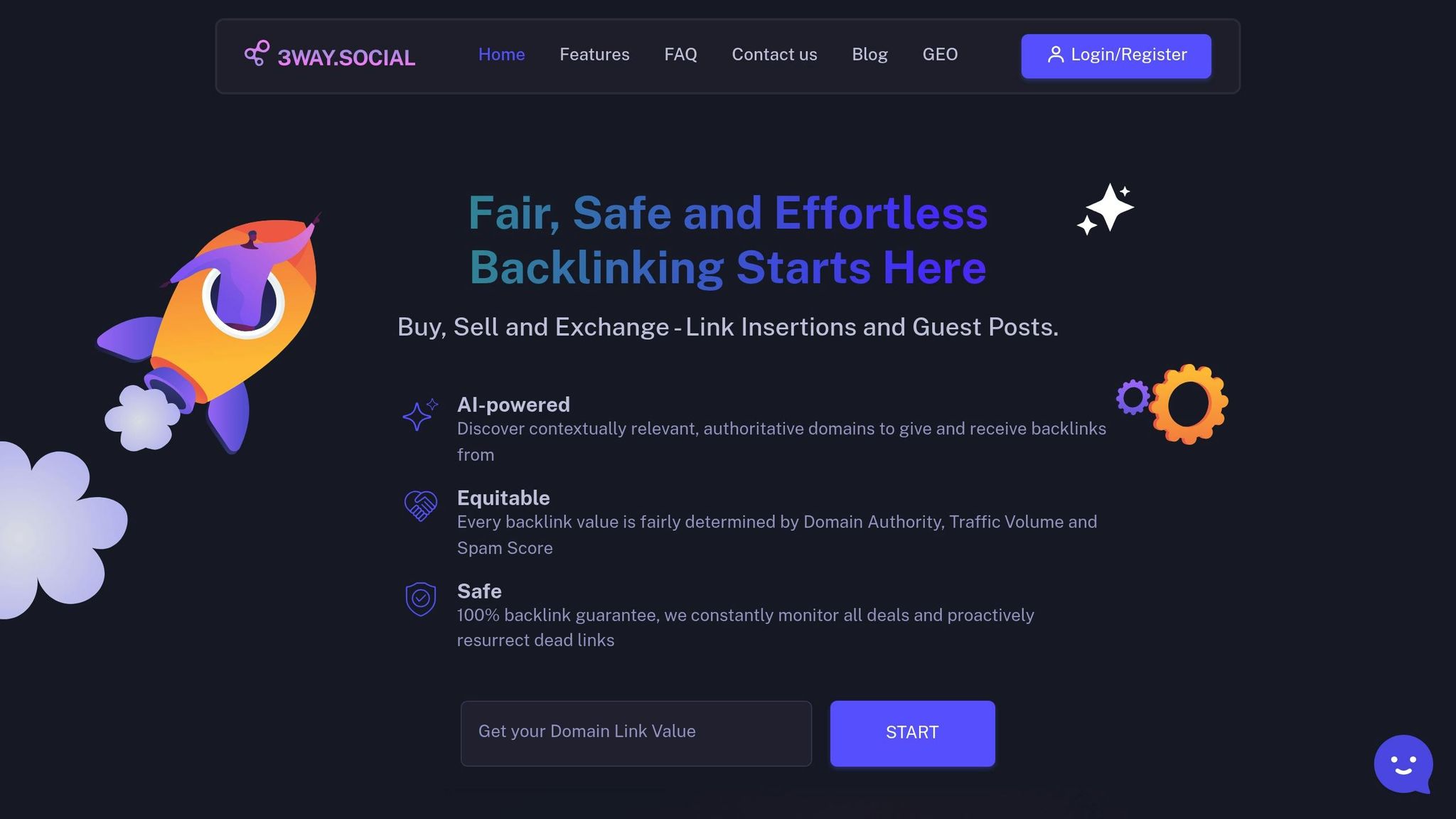Last Updated on September 8, 2025 by Becky Halls
When selecting domains for link-building, relying solely on current metrics can lead to poor decisions. Historical data offers a clearer picture of a domain’s long-term reliability and performance. By analyzing trends like organic traffic, backlink profiles, keyword rankings, and penalties over the past 12–24 months, you can identify stable, trustworthy domains and avoid risky ones.
Key takeaways:
- Why it matters: Current metrics may hide past penalties or ranking drops. Historical data ensures you choose domains with consistent growth and resilience.
- Metrics to track: Organic traffic trends, backlink evolution, ranking stability, domain authority, and penalty history.
- Tools to use: Platforms like Ahrefs, SEMrush, Google Search Console, and 3Way.Social (AI-powered) simplify data analysis.
- How to act: Regularly monitor domains for changes, compare metrics, and focus on those with proven stability and relevance to your niche.
Historical data transforms domain matching into a process based on facts, reducing risks and improving outcomes for your SEO strategy.
What is Historical Domain Performance Data
Definition of Historical Domain Performance Data
Historical domain performance data consists of measurable metrics that track how a website has performed over time. These include organic traffic trends, backlink acquisition and loss, keyword ranking changes, domain authority shifts, and records of penalties or recoveries.
Unlike a current snapshot of performance, historical data provides a deeper look into seasonal traffic patterns, the effects of algorithm updates, content strategy adjustments, and technical challenges. It paints a detailed picture of how a domain has responded to various factors influencing its search performance.
This data typically covers 12–24 months or more, offering meaningful insights into long-term trends. Advanced SEO tools now make it easier than ever to track these metrics, creating timelines that highlight when significant changes occurred and how the domain reacted. Such insights are essential for assessing a domain’s trustworthiness, which we’ll explore in the next section.
Why Historical Data is Important in Domain Matching
Relying solely on current metrics can be misleading. A domain that appears strong today might be masking a history of penalties, traffic drops, or other issues caused by algorithm updates. Without historical context, you’re essentially making decisions based on incomplete information.
Historical data helps you separate domains with steady, reliable growth from those with erratic performance. Consistency often reflects adherence to search engine guidelines, better content quality, and strong technical upkeep – qualities that are critical when evaluating potential link partners.
This data also reveals how well a domain handles algorithm updates. Domains that consistently maintain their rankings through major Google updates demonstrate resilience and quality. By contrast, domains with unstable traffic or a history of manipulative tactics could harm your site’s reputation if partnered with.
Key Metrics to Track in Historical Data
To make the most of historical performance data, focus on these key metrics:
- Organic traffic trends: Look for steady growth or predictable seasonal patterns. Dramatic spikes or drops could signal issues with content strategy or technical problems.
- Backlink profile evolution: Examine how the domain has built its authority over time. Sudden surges in backlinks followed by sharp losses may indicate link schemes or penalties. Pay close attention to the quality of linking domains and whether the profile has improved or declined.
- Keyword ranking stability: Consistent rankings for target keywords suggest strong optimization and content quality. Frequent ranking fluctuations may point to technical errors, content gaps, or risky SEO practices.
- Domain authority progression: A reliable domain shows either steady improvement or consistent stability in authority. Significant drops in authority could signal deeper issues that current metrics alone might not reveal.
- Penalty and recovery patterns: Investigate any history of penalties, whether manual or algorithmic. Domains that have faced multiple penalties or took a long time to recover may pose a risk, even if they currently appear stable.
- Technical performance history: Metrics like page speed, mobile optimization, and Core Web Vitals provide insight into a domain’s long-term technical reliability. Consistent technical standards are a strong indicator of a dependable link partner.
Tools and Platforms for Finding Historical Data
Popular SEO Tools for Historical Data
When it comes to analyzing historical data for domain matching, a variety of SEO tools stand out for their unique capabilities.
Ahrefs offers a deep dive into backlink history with its massive database. It lets you track when domains gained or lost backlinks over the years. This makes it easier to pinpoint issues, like sudden drops that might signal penalties or other red flags.
SEMrush is excellent for monitoring keyword rankings and organic traffic trends. With its Position Tracking feature, you can observe how domains have performed for specific keywords over time. Meanwhile, Traffic Analytics helps uncover seasonal patterns and fluctuations, making it easier to separate consistent performers from those with erratic trends.
Google Search Console delivers reliable data straight from Google itself, although it’s limited to the past 16 months. The Performance report highlights key metrics like search impressions, clicks, and position changes over time. While its coverage is shorter than other tools, the accuracy and authority of this data are unmatched.
Moz Pro focuses on tracking domain authority over time through its Link Explorer. This tool reveals how a domain’s authority has evolved, helping you spot steady growth or sudden declines. Its spam score feature is particularly useful for identifying risky domains with problematic backlink histories.
Wayback Machine adds another layer of insight by showing how websites looked and functioned at different points in their history. This is invaluable for verifying whether domains maintained consistent content quality or made questionable changes, like suspicious redirects or structural overhauls.
Each of these tools provides unique perspectives on historical data. Together, they offer a well-rounded foundation for evaluating domain quality. But if you’re looking for a more automated approach, platforms like 3Way.Social take things a step further with AI-driven analysis.
How 3Way.Social Uses AI for Domain Matching

3Way.Social builds on the insights offered by traditional tools, using AI to simplify and enhance the domain-matching process. Instead of relying on manual research, the platform’s algorithms analyze large volumes of historical data to evaluate domain quality and performance.
The AI examines critical metrics such as traffic trends, backlink growth, ranking consistency, and authority changes over time. By cross-referencing these data points, the system identifies domains that exhibit steady, reliable performance – saving users the time and effort of sifting through data manually.
A key differentiator for 3Way.Social is its emphasis on fair partnerships. The platform doesn’t just identify high-performing domains; it also ensures they align with your niche and audience quality. By analyzing historical data like domain authority and traffic patterns, the system pairs you with domains that offer mutual value.
To protect users, the platform automatically filters out domains with red flags. If a domain shows signs of penalties, manipulative link-building practices, or inconsistent performance, the AI flags it and excludes it from the matching pool. This minimizes the risk of partnering with domains that could harm your reputation.
What’s more, 3Way.Social’s AI adapts to search engine updates. By constantly monitoring how different domains perform after algorithm changes, the platform adjusts its criteria to align with the latest SEO standards. This ensures that the recommended partnerships remain relevant and effective, even as search engine priorities evolve.
How to check the domain history of a website (important step in the SEO audit process)
Step-by-Step Guide to Using Historical Data for Domain Matching
Using historical data for domain matching requires a structured approach that blends data collection, analysis, and comparison. Here’s how to tackle it effectively.
Collect and Organize Historical Data
Start by pulling data from multiple SEO tools to ensure you’re covering all relevant domains. Define your focus by listing the domains, subdomains, and link types that align with your SEO goals – this might include main domains, subdirectories, international versions, and related properties.
Automate the data collection process wherever possible. For example, use API connections or set up scheduled reports. Tools like Ahrefs can deliver weekly backlink updates, while SEMrush can automatically track keyword rankings for your targeted domains.
Gather both real-time data for immediate insights and historical data to spot long-term trends. Key metrics to track include referring domains, traffic patterns, and domain authority over time. Establish baseline metrics – such as total referring domains, current domain authority, and anchor text distribution – to help monitor progress and identify notable changes. Once you’ve collected the raw data, organize it into actionable categories using summary tables or visual tools like graphs. This makes analysis and decision-making much easier.
Check Domain Reputation and Past Performance
A domain’s history can reveal potential risks that might harm your link-building efforts.
Start by looking into its penalty history. Watch for sudden drops in organic traffic, ranking declines, or changes in the backlink profile that could point to past Google penalties. Google Search Console is a valuable tool for checking manual actions or algorithmic penalties.
Examine backlink acquisition patterns over time. Healthy domains tend to show steady, natural growth in their backlink profiles. However, a sudden surge followed by a steep drop could indicate shady link-building practices. Also, review the types of websites linking to the domain – if many are from low-quality directories or link farms, that’s a red flag.
Check for content consistency using archived sources. Look for major website changes, suspicious redirects, or abrupt content shifts that might suggest the domain has changed ownership or focus. Tools like SEMrush’s Traffic Analytics can help you assess traffic stability. Natural seasonal fluctuations are normal, but erratic or consistently low traffic may signal trouble. Lastly, evaluate the domain’s technical health by checking for extended downtimes, server issues, or security lapses that could impact search engine crawling and indexing.
Compare Domains Using Key Metrics
Once you’ve analyzed individual domains, compare them using key metrics to identify the best opportunities for partnerships.
Focus on Domain Power (DP) as a reliable indicator of SEO value. Domains with quality backlinks generally drive stronger traffic and rankings. Look for consistent backlink quality and traffic trends. Favor domains that have earned links organically from credible and relevant sources over those with large but low-quality backlink profiles.
Pay attention to the semantic alignment between potential anchor text opportunities and your target keywords. Research shows that semantic similarity between anchor texts and supported keywords can improve by 69.6% after strategic placement.
Recent studies highlight the impact of strategic backlink placements: traffic gains can exceed 200%, and individual page rankings often improve by an average of 10.8%. For example, the median number of ranking keywords per page can jump from 12 to 30 after placement – a roughly 150% increase.
Use tables to compare metrics like Domain Power, traffic trends, and backlink quality. Domains showing consistent Domain Power growth – from an average of 83.7 to 94 after placement – or steady organic traffic growth over the past 12–24 months are typically better long-term partners.
Finally, consider the contextual quality of potential backlinks. Domains offering semantically relevant anchor text and links placed within related content are more likely to deliver strong SEO results than those providing generic link placements. Once you’ve completed your comparisons, you’ll be ready to use this analysis to strengthen your link-building strategy.
Using Historical Data to Improve Domain Matching
Leveraging historical data can help you zero in on the best domains for link-building. Below, we’ll explore how to use these insights to identify quality domains, avoid risky ones, and rank them effectively for your campaigns.
Finding High-Quality Domains
To find strong domains, focus on those with consistent traffic and natural backlink growth. Steady organic growth over the last 12-24 months is a good indicator of reliability. Avoid domains with sudden traffic spikes followed by sharp drops, as these patterns often suggest temporary boosts or artificial growth strategies.
Examine backlink profiles for gradual, natural growth. The best domains attract links from diverse, authoritative sources over time. Look for a steady increase in referring domains without abrupt jumps, which could indicate manipulative link-building. Also, pay attention to anchor text ratios – a healthy mix of branded and non-branded terms suggests genuine authority in their niche.
Domains that publish content regularly tend to be more stable. Use tools to check how often they add or update pages. A consistent schedule of 2-4 high-quality posts per week is a good sign of long-term performance.
For revenue-driven sites, historical patterns can reveal a lot. E-commerce domains often show seasonal traffic trends tied to their industry, while maintaining a baseline level of activity during slower months. Service-based businesses, on the other hand, typically exhibit steady organic growth over time.
Platforms like 3Way.Social use AI to analyze these historical trends, automatically pinpointing domains with reliable performance metrics and solid backlink profiles. Their quality filters make it easier to focus on domains with proven stability and growth.
Avoiding Risky Domains
Spotting red flags in historical data is just as important as identifying strong domains. Risky domains can harm your link-building efforts, so tread carefully.
One major warning sign is sudden spikes in backlinks. These could indicate artificial link-building campaigns, which might not trigger penalties immediately but could lead to future vulnerabilities.
Pay attention to changes in content quality. Some domains start strong but later shift to lower-quality content – thin, duplicate, or AI-generated – to cut costs. This often results in declining organic traffic and diminished trust from search engines. Use archived snapshots of key pages to detect any downward trends in content standards.
Technical issues in a domain’s history can also signal trouble. Frequent downtime, slow load speeds, or poor mobile usability can hurt search rankings over time. Domains with recurring technical problems are less reliable for long-term strategies.
Ownership changes are another factor to watch. When domains change hands, new owners might overhaul content, design, or linking practices, which can harm existing SEO value. Look for abrupt shifts in topics, layouts, or backlink patterns, as these often signal new priorities that could conflict with your goals.
Ranking Domains Based on Performance Data
Once you’ve gathered data, rank potential domains by combining metrics like authority trends, traffic stability, and niche relevance. This ensures your link-building efforts are focused on the best opportunities.
Start with authority trends. Favor domains that show steady growth in authority over the past 6-12 months. Pair this with an analysis of traffic stability – calculate the coefficient of variation for monthly organic traffic over the last year. Domains with lower variation scores are more predictable and safer for investment.
Next, assess niche relevance. Domains that consistently cover topics related to your industry carry stronger topical authority. Links from these sites are more valuable, as they drive engaged users who are more likely to interact with your content.
Look at link placement history as well. Domains that regularly provide contextual links within content tend to offer better SEO benefits compared to sidebar or footer links. Historical data can reveal which domains prioritize these high-value placements.
Lastly, consider financial factors like cost-per-acquisition trends. Review past collaborations to identify domains that deliver consistent results without unexpected price increases. This helps you allocate your budget to domains that offer the best return on investment.
Combine these metrics into a composite ranking tailored to your goals, whether it’s traffic growth, authority building, or brand awareness. Domains scoring in the top 20% across multiple categories usually deliver the best results. To keep your strategy effective, re-evaluate these rankings quarterly. Fresh data ensures you stay ahead of algorithm changes, market shifts, and other variables that impact domain performance.
sbb-itb-88880ed
Best Practices for Monitoring and Updating Historical Data
Domain matching is a continuous process because algorithms evolve, and domain performance can shift over time. Without consistent monitoring, even well-chosen domains can lose their edge or become problematic. Here’s how to keep your historical data relevant and ensure your domain matching strategy remains effective.
Setting Up Regular Monitoring Processes
Once you’ve completed your initial domain analysis, regular monitoring becomes essential for maintaining SEO performance. A structured system for tracking domain performance over time can save you from surprises. For most projects, monthly reviews work well, but for high-priority domains, more frequent checks might be necessary.
Start by establishing baseline metrics for each domain. Use automated tools to set alerts for changes in traffic, backlink profiles, or other key indicators. It’s also helpful to analyze trends, such as seasonal traffic shifts or changes in domain ownership. For example, e-commerce sites often see spikes during the holiday season, while B2B domains may follow quarterly business cycles. Recognizing these patterns can help you optimize your outreach timing.
Ownership changes can also impact a domain’s SEO value. Regularly check WHOIS data to spot any updates. A new owner might introduce a different content strategy or linking approach, which could affect the domain’s relevance to your goals.
Tools like 3Way.Social’s AI can simplify this process by automating monitoring tasks. These tools flag potential issues before they escalate, saving you from the hassle of manual checks.
Additionally, keep detailed records of your outreach efforts. Metrics like response times, acceptance rates, and the quality of placements can help you identify which domains consistently perform well and which might need to be reconsidered.
Adjusting to Algorithm Changes
Monitoring alone isn’t enough – your strategy needs to adapt whenever search engines update their algorithms. These updates can quickly shift a domain’s value, so staying informed is key to maintaining a strong portfolio.
Keep an eye on ranking fluctuations during algorithm rollouts. If a domain experiences a sustained drop in visibility, it could signal an issue such as an algorithm penalty or a shift in relevance for its niche.
Focus on E-A-T (Expertise, Authoritativeness, Trustworthiness) signals. Domains that once ranked highly might falter if they no longer demonstrate clear expertise. Features like detailed author bios, verified credentials, and transparent fact-checking processes can make a difference.
Content standards are always evolving too. Search engines are getting better at recognizing high-quality, human-written content. Sites that prioritize well-researched and thoughtfully written material tend to perform better than those relying on automated content.
Some industries face stricter scrutiny than others. For example, healthcare and finance domains often fall under YMYL (Your Money or Your Life) guidelines, which demand higher editorial standards. Prioritize domains in these fields that showcase strong expertise and credibility.
When major updates roll out, avoid making immediate changes. Temporary ranking shifts are common and don’t always reflect long-term trends. Take time to evaluate whether fluctuations are part of a broader pattern.
Industry-specific updates, like Google’s Product Reviews update or the Helpful Content Update, can also have unique effects. Staying connected with SEO communities and keeping up with industry news can provide valuable insights into how these changes might influence your domains.
Finally, have contingency plans in place. If a key domain in your portfolio is hit hard by an update, backup options can help you mitigate risks. These practices ensure your domain matching strategy stays aligned with search engine standards and continues delivering strong SEO results.
Conclusion: Key Points on Using Historical Data for Domain Matching
Using historical data transforms domain matching into a smarter, more strategic process. By digging into past performance metrics, you can pinpoint domains that consistently deliver strong SEO results while steering clear of those with hidden pitfalls or declining authority.
Here’s a quick game plan: Start by collecting the data we discussed earlier. Check domain reputation by investigating past penalties, changes in ownership, and shifts in content. Use solid metrics for comparison instead of relying on surface-level indicators, and set up regular monitoring to quickly identify performance changes. This ongoing approach helps your link-building strategy stay ahead as SEO trends shift.
Regular monitoring is essential to keep your strategy relevant. Domain matching isn’t a one-and-done task – search algorithms change, and domain performance can fluctuate. The monitoring and adjustment techniques we’ve covered will help you stay on track and ensure your efforts continue to deliver results.
With tools like 3Way.Social’s AI, this process becomes even more efficient. The platform automates analysis, offers smart recommendations, and uses a vetted network with quality control filters, saving you from the time-consuming manual research that older methods require.
Prioritize a handful of well-researched, reliable domains over a large quantity of lower-quality ones. Use the metrics we’ve outlined to rank domains based on their stability and reliability, focusing on those with a proven track record of maintaining SEO value over time.
FAQs
Why is it better to analyze historical data instead of just current metrics when choosing domains for link-building?
Why Analyzing Historical Data Matters
Taking a close look at historical data is key to understanding a domain’s long-term performance, reputation, and backlink trends. While current metrics give you a quick view of where a domain stands today, historical data uncovers patterns that show whether a domain has consistently maintained authority and reliability over time.
Digging into this data can also help you steer clear of domains with a problematic past – like penalties or spammy backlinks – that might not show up in current metrics. By factoring in historical trends, you can make smarter decisions for your link-building strategy, ensuring it’s built on a solid foundation and supports steady SEO growth.
What historical metrics should I review to assess a domain’s reliability and performance over time?
To assess a domain’s reliability and performance over time, pay attention to domain age, historical trends in domain authority, and the quality and stability of backlinks it has acquired. These elements reveal how stable and dependable the domain has been.
It’s also important to examine consistent performance in metrics like traffic trends and ranking stability. Domains with steady metrics are less prone to sudden dips in value. Focusing on these factors helps ensure your link-building strategy supports long-term SEO success.
How does 3Way.Social use historical data to improve domain matching?
How 3Way.Social Enhances Domain Matching
3Way.Social uses historical data to fine-tune domain matching, making it more precise and impactful. By diving into metrics like domain authority, backlink quality, and engagement patterns, the platform pinpoints domains that perfectly align with your SEO objectives.
What sets 3Way.Social apart is its use of AI-powered algorithms. These tools not only analyze past performance but also predict how domains might perform in the future. Plus, the matching process is automated, streamlining your link-building strategy. The result? You can focus your efforts on domains with a proven history of success, paving the way for higher rankings, increased traffic, and enhanced domain authority over time.



